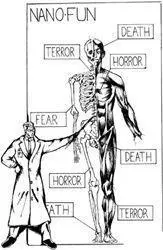Handy Tips to Stop a Nanotech Infestation in Your Body
• Live in a cave forever.
• Swing your arms about wildly, as if swatting invisible insects.
• Hide your blood.
Horrifyingly, that’s how!
Scientists recently broke this fuel barrier when they started powering medical nanobots with the reengineered tails of human sperm. It’s quite an elegant solution, really: Sperm are perfectly functioning, natural motors that power themselves solely on glucose, a chemical already naturally present in the human body. And this system also knocks down another barrier of the fundamental capabilities needed for a Goo-bot to function, which is combating the human metabolism. Glucose is a perfect fuel for any use within the human body, so these natural engines could be used on any biological robot, from cancer-fighting nanobots to system-enhancing modifications. Researchers are looking into using these things for anything from curing paralysis to reducing asthma. So on the plus side, there might just be a new weapon in the battle against disease. On the downside, that weapon is basically cum in your blood. Hey, at least homophobia will die off pretty quickly, when all bigots refuse treatment because their organs “ain’t no queers.”
Potential Upsides to a Gray Goo Infestation in Your Body
• You’ll never be alone again.
• It probably tickles.
• Parts of you will live forever! (Or at least long enough to disassemble your loved ones.)
The third element a self-replicating nanobot would require to function would be an incredibly sturdy shell. Microscopic machines not only have to endure the intense atmospheric pressures of the body and atmosphere, but also need to fight off interference from sunlight, bacteria, temperature—basically everything. Sure, it’s a hard-knock life, nanobots, but that’s what you get for being a doomsday scenario. What did you expect, pity? You want to turn our stomachs into your children, nanobots; we have no sympathy for you here.
The fourth fundamental is control, because what’s the point of having a roving, armored nanobot if it just wanders around aimlessly with no clear goal in mind, stumbling awkwardly through your blood with absolutely no purpose in life, like a tiny little robotic teenager?
And finally, the last fundamental is that of fabrication: A nanobot would need to constantly carry around all the tools it needs to build more of itself, in addition to the tools needed for whatever job it was engineered for. These things are smaller than bacteria, so there’s not exactly room for a carry-on.
All of this adds up to a simple realization: There’s just no call for a self-replicating nanobot. It is not only impractical, but actively dangerous. Why go through that if there’s an easier, cheaper, safer solution?
See? Everything’s cool.
No, really, buck up, friends! Those little robot fiends are impotent! Aside from tiny feelings of cybernetic frustration, a gaggle of wee unsatisfied female robots, and some itty-bitty inklings of machine inadequacy, there are no negative consequences!
Nobody dies today!
Why, Eric Drexler himself states that Gray Goo has become a scaremongering scenario that only takes away from more pressing concerns regarding nanotech. Chris Phoenix, Director of Research at the Center for Responsible Nanotechnology, also states quite clearly that it is a nonissue:
Runaway replication would only be the product of a deliberate and difficult engineering process, not an accident. Far more serious, however, is the possibility that a large-scale and convenient manufacturing capacity could be used to make powerful nonreplicating weapons in unprecedented quantity, leading to an arms race or war. Policy investigation into the effects of molecular nanotechnology should consider deliberate abuse as a primary concern, and runaway replication as a more distant issue.
So that’s… comforting, I guess? He’s saying that Gray Goo won’t ever happen on accident! Admittedly, it would be slightly more comforting if he didn’t also say, practically in the same breath, that you shouldn’t worry about Gray Goo happening on accident , because it’s only going to happen on purpose , and even then only if far more terrifying things do not happen first. Jesus, hopefully nobody’s turning to cry on Phoenix’s shoulder, because he certainly didn’t get his doctorate in compassion.
Better Names for Gray Goo
• Steel Pudding
• Robot Death Buffet
• Reverse Voltron Disorder.
However, who would ever want to engineer it on purpose? Gray Goo wouldn’t be appealing for military purposes because it’s so hard to control and so wantonly destructive. When other nanotech weapons can be used far more effectively to kill with control, who would want something that just randomly destroys life and sows chaos? Only psychopaths and terrorists want that kind of stuff.
Oh, wait; we have a whole bunch of those around, don’t we?
In light of this fact, the Center for Responsible Nanotechnology realized that they couldn’t scratch Gray Goo off their list of concerns just yet, but did add that it was a low-priority threat because there were “far more dangerous and imminent issues with nanotechnology.”
There were far more dangerous issues than sperm-powered blood robots eating the Earth.
That’s what they said.
They think that’s comforting.
“I’m so sorry, sir. You have terminal cancer. But don’t worry; it’s all going to be OK! You won’t be dying from the cancer… because I am going to shoot you in the face right now. Isn’t that reassuring?”
No, Center for Responsible Nanotechnology, that is not comforting. I would suggest you offer hugs instead of these horrifying press releases, but judging by your previous “consolation” track record, I’m afraid you’d just end up whispering obscenities in people’s ears while punching their children.

WITH ALL THE CURRENT fearmongering about nanotechnology—most of which has been done within the confines of this book—it’s not actually very likely that the nanobots are going to build their children out of the last sad remnants of Earth or inspire a deadly new team of superanimals like the world’s tiniest Legion of Doom.
But don’t worry, that doesn’t mean we’re not all going to die anyway!
This is because even the most benevolent of nanobots share one simple, undeniable commonality: To achieve any major effects, there are going to have to be a lot of them and, though it is infinitesimal, they do take up some space. When their purpose is complete, they’ll deactivate and die off—unfortunately leaving their corpses where they lie.
But so what? Aside from the hassle of having to construct a plethora of mini tombstones (and the rather gross prospect of microscopic widows getting grief fucked inside your teeth), how could this possibly affect you? Well, the primary application for a lot of this nanotech is going to be for health issues: improving stamina, boosting immune systems, and fighting off cancer. All those corpses are basically just litter, and the human body is their environment, which means that when they die, they die inside of you . And if you think this scenario—that you’ll be poisoned to death by the corpses of miniature robots that live inside your blood just like that hobo down by the library keeps screaming—sounds somewhat outlandish, then you should know one little thing: It’s already happening.
Читать дальше













